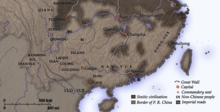Qin invasion of Guangdong
| Qin's campaign against the Yue tribes | |||||||
|---|---|---|---|---|---|---|---|
 |
|||||||
|
|||||||
| Belligerents | |||||||
| Qin empire | Baiyue | ||||||
As trade was an important source of wealth for the Yue tribes of coastal China, south of the Yangtze River attracted the attention of Emperor Qin Shi Huang to undertake a series of military campaigns to conquer it. Lured by its temperate climate, fertile fields, and relative security from the warring factions from the west and northwest, the wealth and access to luxury tropical products from Southeast Asia motivated the First Emperor to send an army to conquer the Yue kingdoms. The emperor craved for the resources of the Baiyue and dispatcjed military expeditions against the region between 221 and 214 BC. It would take Emperor Qin Shi Huang five successive military excursions before finally defeating the Yue in 214 BC.
After Qin Shi Huang defeated the state of Chu in 223 BC, the nascent Qin dynasty in 214 BC undertook a military campaign against the Baiyue in Lingnan to conquer the territories of what is now southern China and northern Vietnam. The emperor ordered his armies to advance southward in the five columns to conquer and annex the Yue territories into the Qin empire. Motivated by the region's vast land and valuable exotic products, Emperor Qin Shi Huang secured his boundaries to the north with a fraction of his large army, and sent the majority south to seize the land and profit from it while attempting to subdue the barbarian Yue tribes of the southern provinces. The Ouyue in southern Zhejiang and the Minyue in the Fujian province soon became vassals of the Qin empire. The Qin armies would unfortunately face fierce resistance from the Nanyue in Guangdong and Guangxi. At that time, southern China was known for its vast fertile land, elephant tusks, rhinoceros horns, kingfisher feathers, ivory, pearls, and jade production. Prior to the events leading to Qin dominance over China, the Baiyue had gained possession of much of Sichuan to the southwest. The Qin army was unfamiliar with the jungle terrain, and was defeated and nearly annihilated by the southern Yue tribes' guerrilla warfare tactics, the Qin commander killed while suffering casualties of over 10,000 men. Despite these motivations, the central imperial government would begin to promote a series of policies for assimilating the ethnic Yue minorities through sinicization.
The Qin empire managed to construct the Lingqu Canal to the south, which they used heavily to supply and reinforce their troops during a second attack to the south. The Linqu canal connected the headwaters of the Xiang River in the Yangzi basin with the Li River flowing into the West River basin. The Qin had extended the construction of canals towards the southern coast in order to profit from international maritime trade coming from Nanhai and the Indian Ocean. Nanhai was a strategic attraction for the Qin as it provided an outstanding opening for maritime trade with Southeast Asia, the Indian subcontinent, the Near East, and the European Roman Mediterranean. The canal would facilitate the transportation of military supplies to the Qin troops and prisoners to the Lingnan region for securing and expanding the Qin's borders. With the Qin's superior armament and disciplined military organization of the Qin army, the Qin forces would ultimately prevail over the Yue tribes. By 214 BC, Guangdong, Guangxi, and northern Vietnam were subjugated and annexed into the Qin empire. Building on these gains, the Qin armies conquered the coastal lands surrounding Guangzhou and took areas of Fuzhou and Guilin. The annexed territories were partitioned and administered into new three prefectures of the Qin empire. Partitioned into four territories, each with its own governor and military garrison, these coastal territories became the business epicenter of Chinese maritime activity and international foreign trade. During this time, Guangdong was a vastly underdeveloped and primitive semitropical frontier region of forests, jungles, and swamps inhabited by elephants and crocodiles. The cessation of war of the Yue in Lingnan, Qin Shi Huang began his efforts to sinicize the original inhabitants. He imposed sinification by importing Han Chinese settlers to displace, weaken, and ultimately eliminate the indigenous Yue culture and sense of Yue ethnic consciousness to prevent nationalism that could potentially lead to the desire of independent states. In addition to promoting immigration, Qin Shi Huang imposed the use of the Han Chinese written script as new language and writing system that replaced the indigenous proto-Yue writing system. To exercise even greater control to sinicize and displace the indigenous Yue, Qin Shi Huang forced the settlement of thousands of Han Chinese immigrants, many of which were convicted felons and exiles to move from northern China to settle in the newly annexed Qin domains. Though the Qin emperor was victorious against the Yue kingdoms, Chinese domination was brief and the collapse of the Qin dynasty led the Yue peoples to regain their independence.
...
Wikipedia
